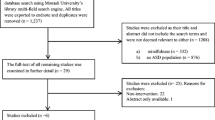Abstract
Individuals with autism spectrum disorders (ASD) have a higher incidence of comorbid disorders in comparison with other patient groups. Empirical evidence on treatments targeting comorbid symptoms is however scarce. Earlier research showed that mindfulness-based therapy for individuals on the autism spectrum (MBT-AS) is effective in reducing symptoms of depression, anxiety, and rumination. In the current study, it was examined whether MBT-AS is effective in alleviating a variety of psychosomatic symptoms and whether these effects were still evident after 9 weeks. Fifty participants took part in a nine-week MBT-AS training. Self-reported symptoms were evaluated at three intervals: (1) before the first session, (2) after the last session, and (3) 9 weeks after the last session. Results showed that symptoms of anxiety, depression, agoraphobia, somatization, inadequacy in thinking and acting, distrust and interpersonal sensitivity, sleeping problems, and general psychological and physical well-being declined significantly during intervention. Positive affect increased, and rumination declined significantly during treatment. Hostility symptoms did not decline significantly during treatment. All symptoms remained stable between post intervention and follow-up. This would seem to indicate that MBT-AS is effective in reducing psychological and physical symptoms and keeping them stable over the longer term. Furthermore, the outcome indicates that rumination is an important mediating factor. In conclusion, MBT-AS appears to be an effective method for reducing a variety of symptoms, and treatment gains remain stable over the longer term.
Similar content being viewed by others
References
Alberts, H. (2013). RRQ - Rumination-Reflection Questionnaire. Retrieved via: http://www.mindfulness-extended.nl/content3/wp-content/uploads/2013/07/RRQ-Rumination-Reflection-Questionnaire1.pdf, on: October 2nd, 2013
American Psychiatric Association. (2000). Diagnostic and statistical manual of mental disorders (4th edition, text revision). Arlington, VA: American Psychiatric Publishing. doi:10.1176/appi.books. 9780890423349.
American Psychiatric Association. (2013). Diagnostic and statistical manual of mental disorders (5th edition). Arlington, VA: American Psychiatric Publishing. doi:10.1176/appi.books.9780890425596.744053.
Arrindell, W. A., & Ettema, J. H. M. (2003). Handleiding bij een multidimensionele psychopathologie-indicator. [Manual of a multidimensional indicator of psychopathology]. Lisse, the Netherlands: Swets.
Baron-Cohen, S. (2001). Theory of mind and autism: a review. Special Issue of the International Review of Mental Retardation, 23, 169–204.
Bishop-Fitzpatrick, L., Minshew, N. J., & Eack, S. M. (2012). A systematic review of psychosocial interventions for adults with autism spectrum disorders. Journal of Autism and Developmental Disorders. Advance online publication: doi:. doi:10.1007/s10803-012-1615-8.
Bradley, E., & Bolton, P. (2006). Episodic psychiatric disorders in teenagers with learning disabilities with and without autism. British Journal of Psychiatry, 189, 361–366. doi:10.1192/bjp.bp.105.01.8127.
Bränström, R., Duncan, L. G., & Moskowitz, J. T. (2011). The association between dispositional mindfulness, psychological well-being, and perceived health in a Swedish population-based sample. British Journal of Health Psychology, 16, 300–316. doi:10.1348/135910710X501683.
Brown, K. W., & Ryan, R. M. (2003). The benefits of being present: mindfulness and its role in psychological well-being. Journal of Personality and Social Psychology, 84, 822–848. doi:10.1037/0022-3514.84.4.822.
Buckelew, S. P., Burk, J. P., Brownelee-Duffeck, M., Frank, R. G., & DeGood, D. (1988). Cognitive and somatic aspects of depression among a rehabilitation sample: reliability and validity of the SCL-90-R research subscales. Rehabilitation Psychology, 33, 67–75. doi:10.1037/h0091679.
Cardaciotto, L., & Herbert, J. D. (2004). Cognitive behavior therapy for social anxiety disorder in the context of Asperger’s syndrome: a single-subject report. Cognitive and Behavioral Practice, 11, 75–81. 1077-7229/04/75-81.
Chiesa, A., & Serretti, A. (2011). Review article: mindfulness based cognitive therapy for psychiatric disorders: a systematic review and meta-analysis. Psychiatry Research, 187, 441–453. doi:10.1016/j.psychres.2010.08.011.
Denollet, J. (1993). Emotional distress and fatigue in coronary heart disease: The Global Mood Scale (GMS). Psychological Medicine, 23, 111–121. doi:10.1017/S0033291700038903.
Derogatis, L. R. (1994). SCL-90-R administration, scoring, and procedures manual (3rd ed.). Minneapolis: National Computer Systems.
Fjorback, L. O., Arendt, M., Ørnbøl, E., Fink, P., & Walach, H. (2011). Mindfulness-based stress reduction and mindfuless-based cognitive therapy: a systematic review of randomized controlled trials. Acta Psychiatrica Scandinavica. doi:10.1111/j.1600-0447.2011.01704.x.
Gaus, V. L. (2011). Cognitive behavioural therapy for adults with autism spectrum disorder. Advances in Mental Health and Intellectual Disabilities, 5, 15–25. doi:10.1108/20441281111180628.
George, D., & Mallery, P. (2003). SPSS for Windows step by step: a simple guide and reference. Boston: Allyn & Bacon.
Gilliot, A., & Standen, P. J. (2007). Levels of anxiety and sources of stress in adults with autism. Journal of Intellectual Disabilities, 11, 359–370. doi:10.1177/1744629507083585.
Happé, F., & Frith, U. (2006). The weak central coherence account: detail-focused cognitive style in autism spectrum disorders. Journal of Autism and Developmental Disorders, 36, 5–25. doi:10.1007/s10803-005-0039-0.
Hare, D. J. (1997). The use of cognitive-behavioral therapy with people with Asperger’s syndrome: a case study. Autism, 1, 215–225. doi:10.1177/1362361397012007.
Hofmann, S. G., Sawyer, A. T., Witt, A. A., & Oh, D. (2010). The effect of mindfulness-based therapy on anxiety and depression: a meta-analytic review. Journal of Consulting and Clinical Psychology, 78, 169–183. doi:10.1037/a0018555.
IBM Corp. (2010). IBM SPSS Statistics for Windows, version 19. Armonk, NY: IBM Corporation.
Kabat-Zinn, J. (1982). An outpatient program in behavioral medicine for chronic pain patients based on the practice of mindfulness meditation: theoretical considerations and preliminary results. General Hospital Psychiatry, 4, 33–47.
Kirkegaard Thomson, D., Yung Mehlsen, M., Olesen, F., Hokland, M., Viidik, A., Avlund, K., et al. (2004). Is there an association between rumination and self-reported physical health? A one-year follow-up in a young and an elderly sample. Journal of Behavioral Medicine, 27, 215–231. doi:10.1023/B:JOBM.0000028496.41492.34.
Lai, M. C., Lombardo, M. V., Pasco, G., Ruigrok., A. N. V., Wheelwright, S. J., Sadek, S. A., Chakrabarti, B. & Baron-Cohen, S. (2011). A behavioral comparison of male and female adults with high functioning autism spectrum conditions. PLoS One, 6. doi:http://dx.doi.org/10.1371/journal.pone.0020835
Långström, N., Grann, M., Ruchkin, V., Sjöstedt, G., & Fazel, S. (2008). Risk factors for violent offending in autism spectrum disorder: a national study of hospitalized individuals. Journal of Interpersonal Violence. Advance online publication: doi:. doi:10.1177/0886260508322195.
Lord, C., Risi, S., Lambrecht, L., Cook, E. H., Leventhal, B. L., DiLavore, P. C., et al. (2000). The Autism Diagnostic Observation Schedule–Generic: a standard measure of social and communication deficits associated with the spectrum of autism. Journal of Autism and Developmental Disorders, 3.
Lord, C., Rutter, M., DiLavore, P. C., & Risi, S. (1999). Autism Diagnostic Observation Schedule-WPS (ADOS-WPS). Los Angeles, CA: Western Psychological Services.
Lord, C., Rutter, M., & Le Couteur, A. (1994). Autism Diagnostic Interview-Revised: a revised version of a diagnostic interview for caregivers of individuals with possible pervasive developmental disorders. Journal of Autism and Developmental Disorders, 24, 659–685. doi:10.1016/j.cnr.2006.06.005.
McDougle, C. J., Janice, P., Holmes, R. N., Derek, M. S. N., Carlson, C., Pelton, G. H., et al. (1998). A double-blind, placebo-controlled study of Risperidone in adults with autistic disorder and other pervasive developmental disorders. Archives of General Psychiatry, 55, 633–641. doi:10.1001/archpsyc.55.7.633.
McLaughlin, K. A., & Nolen-Hoeksema, S. (2010). Rumination as transdiagnostic factor in depression and anxiety. Behaviour Research and Therapy, 49, 186–193. doi:10.1016/j.brat.2010.12.006.
Minshew, N. J., Goldstein, G., & Siegel, D. J. (1995). Speech and language in high-functioning autistic individuals. Neuropsychology, 9, 255–261. doi:10.1037/0894-4105.9.2.255.
Nolen-Hoeksema, S., Wisco, B. E., & Lyubomirsky, S. (2008). Rethinking rumination. Perspectives on Psychological Science, 3, 400–424. doi:10.1111/j.1745-6924.2008.00088.
Nyklíček, I., & Denollet, J. (2009). Development and evaluation of the Balanced Index of Psychological Mindedness (BIPM). Psychological Assessment, 21, 32–44. doi:10.1037/a0014418.
Nyklíček, I., & Kuijpers, K. F. (2008). Effects of mindfulness-based stress reduction intervention on psychological well-being and quality of life: is increased mindfulness indeed the mechanism? Annals of Behavioral Medicine, 35, 331–340. doi:10.1007/s12160-008-9030-2.
Pearson Assessments (2013). Symptom Checklist-90-Revised (SCL-90-R®). Retrieved via: http://psychcorp.pearsonassessments.com/HAIWEB/Cultures/en-us/Productdetail.htm?Pid=PAg514&Mode=summary, on: October 2nd, 2013
Ramel, W., Goldin, P. R., Carmona, P. E., & McQuaid, J. R. (2004). The effects of mindfulness meditation on cognitive processes and affect in patients with past depression. Cognitive Therapy and Research, 28, 433–455. 0147-5916/04/0800-0433/0.
Russell, A. J., Jassi, A., Fullana, M. A., Mack, H., Johnston, K., Heyman, I., et al. (2013). Cognitive behavior therapy for comorbid obsessive-compulsive disorder in high-functioning autism spectrum disorders: a randomized controlled trial. Depression and Anxiety, 30, 697–708. doi:10.1002/da.22053.
Salmon, P., Sephton, S., Weissbecker, I., Hoovm, K., & Studts, J. L. (2004). Mindfulness meditation in clinical practice. Cognitive and Behavioral Practice, 11, 434–446. 1077-7229/04/434-44651.00/0.
Sansone, R. A., & Sansone, L. A. (2012). Rumination - relationships with physical health. Innovations in Clinical Neuroscience, 9, 29–34.
Schreibman, L., & Ingersoll, B. (2005). Behavioral interventions to promote learning in individuals with autism. In F. Volkmar, R. Paul, A. Klin, & D. Cohen (Eds.), Handbook of autism and pervasive developmental disorders, 3rd. Edition (pp. 882–896). Hoboken, NJ: John Wiley & Sons, Inc. doi:10.1002/9780470939352.
Segal, Z. V., Williams, J. M. G., & Teasdale, J. D. (2002). Mindfulness-based cognitive therapy for depression: a new approach to preventing relapse. New York: Guilford Press.
Shapiro, S. L., Bootzin, R. R., Figueredo, A. J., Lopez, A. M., & Schwartz, G. E. (2003). The efficacy of mindfulness-based stress reduction in the treatment of sleep disturbance in women with breast cancer: an exploratory study. Journal of Psychosomatic Research, 54, 85–91. doi:10.1016/S0022- 3999(02)00546-9.
Spek, A. A. (2010). Mindfulness bij volwassenen met autisme. [Mindfulness in adults with autism]. Amsterdam: Hogrefe.
Spek, A. A., van Ham, N. C., & Nyklíček, I. (2013). Mindfulness-based therapy in adults with an autism spectrum disorder: a randomized controlled trial. Research in Developmental Disabilities, 34, 246–253. doi:10.1016/j.ridd.2012.08.009.
Spek, A. A., Scholte, E. M., & van Berckelaer-Onnes, I. A. (2008). The use of WAIS-III in adults with HFA and Asperger syndrome. Journal of Autism and Developmental Disorders, 38, 1573–3432. doi:10.1007/s10803-007-0446-5.
Spek, A. A., Scholte, E. M., & van Berckelaer-Onnes, I. A. (2009). Theory of mind in adults with HFA and Asperger syndrome. Journal of Autism and Developmental Disorders, 40, 280–289. doi:10.1007/s10803-009-0860-y.
Swettenham, J. (2000). Teaching theory of mind to individuals with autism. In S. Baron-Cohen, H. Tager-Flusberg, & D. J. Cohen (Eds.), Understanding other minds (pp. 442–456). Oxford: Oxford University Press.
Trapnell, P. D., & Campbell, J. D. (1999). Private self-consciousness and the five factor model of personality: distinguishing rumination from reflection. Journal of Personality and Social Psychology, 76, 284–304.
Watson, D., & Pennebaker, J. W. (1989). Health complaints, stress, and distress: exploring the central role of negative affectivity. Psychological Review, 96, 234–254.
Wechsler, D. (1997). WAIS-III administration and scoring manual. San Antonio, TX: The Psychological Corporation.
Weiss, J. A., & Lunsky, Y. (2010). Group cognitive behaviour therapy for adults with Asperger syndrome and anxiety or mood disorder: a case series. Clinical Psychology and Psychotherapy, 17, 438–446. doi:10.1002/cpp.694.
Williams, K., Wheeler, D. M., Silove, N. & Hazell, P. (2010). Selective serotonin reuptake inhibitors (SSRIs) for autism spectrum disorders (ASD) (Review). Cochrane Database of Systematic Reviews, 4. doi: 10.1002/14651858.CD004677.pub2
Wozniak, J. G., Petty, C., Martelon, M. K., Fried, R., Bolfek, A., Kotte, A., et al. (2013). Psychiatric comorbidity and functioning in a clinically referred population of adults with autism spectrum disorders: a comparative study. Journal of Autism and Developmental Disorders, 43, 1314–1325. doi:10.1007/s10803-012-1679-5.
Acknowledgements
The authors would like to gratefully acknowledge the dedication of the individuals that participated in this study and the colleagues of the Adult Autism Center who assisted in the study. Special thanks go to Lannie Rozema for providing language help.
Author information
Authors and Affiliations
Corresponding author
Rights and permissions
About this article
Cite this article
Kiep, M., Spek, A.A. & Hoeben, L. Mindfulness-Based Therapy in Adults with an Autism Spectrum Disorder: Do Treatment Effects Last?. Mindfulness 6, 637–644 (2015). https://doi.org/10.1007/s12671-014-0299-x
Published:
Issue Date:
DOI: https://doi.org/10.1007/s12671-014-0299-x




